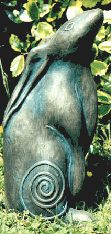Wednesday, October 31, 2012
Hallowtide Transformations
. . . Halloween developed from a pagan holy day, the ancient Celtic feast of Samhain (pronounced sow-in), which was the eve of the new year. It was a time when the veil between this world and the next was at its thinnest, and people and spirits could “cross over,” could pass back and forth between the two worlds. Huge bonfires were lit on hilltops – some say to frighten away evil spirits; others, to warm the souls of the departed. Perhaps both.
. . .[G]ay people who are conscious of having undertaken the often difficult (even scary!) journey of coming out of the closet, are very much open to the idea of new beginnings, of “thin places” (i.e., fragile opportunities), of crossing thresholds and expanding boundaries, of walking in more than one world.
Gay people, like witches of old, are very adept at transformation. And as Michael Ventura points out: “Witch-power is transformative power [within an awareness of] humanity as not entirely of this world, the world of daily life . . . It is to imagine us, rather, as a living gate between this world and worlds beyond. As through humanity were the very membrane through which what we now call ‘information’ passes between the worlds – information, in this case, being force, energy, a kind of wind, through which come messages, healings, destructions, visions, transformations.”
Sherman Alexie [says] the indigenous peoples of the Americas view[ed] gay people as “magical.” Yes, folks, we’re in the realm of the mystics now; of witches, dervishes, bodhisattvas, shamans . . . all those people across time and cultures who, in Ventura’s words, can “consciously place themselves at the gateway or passageway [between the worlds]; take responsibility for being there; and . . . make transformation in this realm possible.”
And I don’t believe that we’re talking only about this reality and a world or worlds beyond it, but the different “worlds” within our reality - the secular world, the church world, the straight world, the gay world. I believe gay people have a special gift and role to play in transforming them all, in one way or another, for the better.
Images: Sylvain Norget.
Monday, October 29, 2012
Saturday, October 27, 2012
Starlight Hare
"The Starlight Hare" is a beautiful work of art by Karen Davis, who lives in the Wiltshire countryside of England. She describes herself as an "artist/illustrator, woodcrafter, mother, daydreamer, nature lover and seeker of magic!"
I love the Earth and the night sky, moonlight, hares, foxes, mistletoe, books, music, the smell of woodsmoke, the scent of bluebells and the song of the robin. I am a night owl. If I was a colour I would be indigo.
– Karen Davis
Monday, October 8, 2012
Friday, October 5, 2012
The Quintessential Quarry
Writes Simon Carnell in Hare:
The earliest extant hunting treatise is composed as if almost everything that can be said about the art can be done so by considering the pursuit of hares with hounds. For Xenophon, roughly 70 percent of whose Cynegeticus or 'Hunting with Hounds' is about hare hunting, the hare is the quintessential quarry, virtually synonymous with the pleasures of the chase — "so pleasing, that whoever sees it trailed, or found, or pursued, or taken, forgets everything he is most attached to." For this retired Greek general writing in the fourth century BC, as for later theorists of the hunt, it is the hare's combination of speed, endurance and 'artfulness' that makes it so suitable for sport. A sport which consisted of following on foot what must have been relatively slow-moving scent-hounds, for he writes that "she is not overtaken by the dogs by speed alone, she is so fast; if they are caught, it is in spite of their natural physique, by accident."
See also the previous post: Vile, Gluttonous, and Cruel
Image: "The Hunted Hare" by Akinga.
The earliest extant hunting treatise is composed as if almost everything that can be said about the art can be done so by considering the pursuit of hares with hounds. For Xenophon, roughly 70 percent of whose Cynegeticus or 'Hunting with Hounds' is about hare hunting, the hare is the quintessential quarry, virtually synonymous with the pleasures of the chase — "so pleasing, that whoever sees it trailed, or found, or pursued, or taken, forgets everything he is most attached to." For this retired Greek general writing in the fourth century BC, as for later theorists of the hunt, it is the hare's combination of speed, endurance and 'artfulness' that makes it so suitable for sport. A sport which consisted of following on foot what must have been relatively slow-moving scent-hounds, for he writes that "she is not overtaken by the dogs by speed alone, she is so fast; if they are caught, it is in spite of their natural physique, by accident."
See also the previous post: Vile, Gluttonous, and Cruel
Image: "The Hunted Hare" by Akinga.
Subscribe to:
Posts (Atom)

























